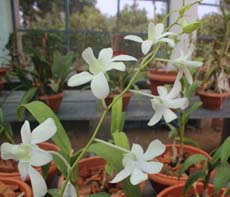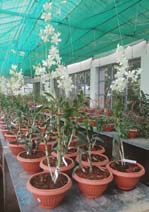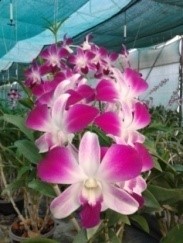cultivation practices
-
climate

Orchids are usually classified as tropical, sub tropical and temperate depending on their temperature requirement for growth and flowering. Most orchids perform well with a 10oC fluctuation between day and night temperatures. Ideal relative humidity is 50-70%.
-
Propagation
Hardened, tissue-cultured plants are recommended for commercial cultivation. Monopodial orchids can be propagated by stem cuttings, flower stalk cuttings and by layering e.g., Vanda, Phalaenopsis. Sympodial orchids can be propagated by division, off-shoots / keikis and back bulbs e.g., Dendrobium, Oncidium.
-
potting media
An ideal potting medium for orchids must be well aerated and porous, hold sufficient moisture and have adequate drainage, must be easily available locally and cheap, and must not contain any toxic substances. Broken bricks, gravel, tile bits, charcoal, coconut husk bits, tree fern, etc. are some of the components of media used for growing epiphytic orchids. The components are washed thoroughly before filling the pots. For terrestrial a mixture of humus, leaf mould, dried manure, chopped fern fibre and spaghnum moss are suitable.
-
Containers and planting
Orchids can be planted in containers such as plastic pots, clay orchid pots, wooden baskets, wire baskets and coconut shells and can also be mounted on cork slabs and driftwood. Monopodial orchids are placed at the centre of the pot and the medium is firmed, whereas, sympodial orchids are planted towards the rim of the pot to allow new growth and for flowers to grow towards the centre of the pot. Orchids can also be grown in trenches filled with potting media which is a common practice in epiphytic monopodial and terrestrial orchids.
-
re-potting
This is an important operation and has to be done once the plants have overgrown the pots or the potting media begins to crumble. The plants are removed, divided, old and dried roots and shoos removed, treated with fungicide and planted in a fresh media.
staking
It is an important operation to maintain the appearance of spike and prevent it from bending.
-
IRrigation

The pH of the irrigation water should ideally be 5.5 - 6.5 and the water should be free from salts of Ca, Mg and Na. Epiphytes need to be sprayed with water and the medium should be just moist, whereas, terrestrials can tolerate wet media. A high-pressure, low-volume irrigation, such as mist-irrigation or fogging (micro-sprinkler) is ideal for maintaining humidity.
-
nutrient requirement
NPK mixture containing 19:19:19 of N, P, K, @ 2 g/l is applied through foliar spray twice a week under tropical conditions during vegetative stages. At flowering, NPK at 1:6:1 increases spike yield and improves quality in Dendrobium. Organic manures like cowdung or neem-cake, soaked in water for 4-5 days for fermentation and, subsequently diluted 10-15 times, may also be used. Tender coconut-water spray (diluted 10 times) is also advocated for spraying young, newly- emerged leaves, for better efficacy.
-
Harvest & post harvest practices
In general, 5-7 spikes per plant are produced during the second year and 6-8 spikes per plant from the third year onwards. Harvesting should be done when most flowers on the spike have opened fully, with two or three buds. Flowers cut prior to maturity will wilt. The stalk is cut at the base, close to the stem, and flamed off or pasted with a fungicide. Harvesting is done in evenings and the spikes are pre-cooled in water before packaging and storage. Grading of spikes is done as per standards. The spikes are inserted into vials containing preservative solution, sleeved and packed in carton boxes for transport.

 Orchids
belonging to family Orchidaceae are flowers of exquisite
beauty and are highly valued as cut flowers and pot
plants in the floriculture trade. These beautiful and
highly specialized flowers display a wide range of
colours, shapes, fragrances and have a very long
vase-life. India has a huge potential for commercial
orchid cultivation in the North-East, along the coastal
regions of Maharashtra, Kerala, Andhra Pradesh, Tamil
Nadu and Karnataka, besides Western Ghats and Andaman &
Nicobar islands.
Orchids
belonging to family Orchidaceae are flowers of exquisite
beauty and are highly valued as cut flowers and pot
plants in the floriculture trade. These beautiful and
highly specialized flowers display a wide range of
colours, shapes, fragrances and have a very long
vase-life. India has a huge potential for commercial
orchid cultivation in the North-East, along the coastal
regions of Maharashtra, Kerala, Andhra Pradesh, Tamil
Nadu and Karnataka, besides Western Ghats and Andaman &
Nicobar islands.